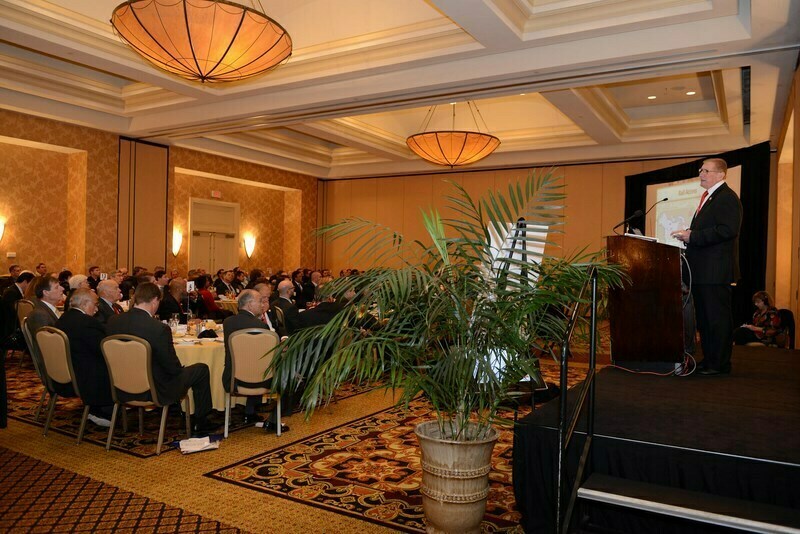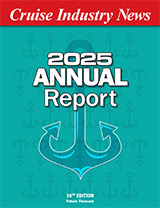
Port of New Orleans President and CEO Gary LaGrange cited numerous Port and industry-wide accomplishments, while challenging local business leaders to think big and act as ambassadors for the maritime community during today’s 27th Annual State of the Port Address hosted by the International Freight Forwarders and Customs Brokers Association of New Orleans at the Marriott Convention Center.
“We don’t always take the proper time to highlight our successes and congratulate ourselves on our victories,” LaGrange said. “I want to challenge everyone today to be good ambassadors wherever you are. Not just for your individual businesses, but for our Port and maritime industry, the Greater New Orleans region and the State of Louisiana.”
LaGrange ticked through a series of best rankings – most notably the No. 1 logistics hub in the nation by Business Facilities Magazine and Forbes Magazine’s top “Brain Magnet.” As a result of improved business climates and intermodal connectivity, LaGrange cited the vast investments being made by energy, chemical, and steel companies throughout Louisiana. New and expanded plants and exporters will spur cargo in the coming years.
Total Breakbulk volume for fiscal year 2013 was 2.78 million tons, up 1.34 percent compared to the previous year. With significant investments in oil and gas infrastructure in North America, as well as the $70 billion of announced investments since 2012 in Louisiana, the Port of New Orleans is well positioned for growth in the breakbulk market, LaGrange said. As evidence, the first six months of 2013 has already shown a 500 percent increase in oil field-related equipment.
In the container market, the increase in export cargo has been a driving growth force. The Port has benefitted from the U.S. Gulf industrial rebirth which has given many chemical companies a cost-competitive advantage. As a result, chemical volumes tripled over the last five years. In 2012, the Port handled 2 million tons of chemicals, and the first six months of 2013 showed a 35 percent increase over the same time frame in 2012.
While the export cargo growth at the Port captured the attention of industry leaders and even President Obama, the Port also realized significant increases in inbound containerized cargo. Shippers and container carriers are capitalizing more and more on the 12-hour rail connection to and from Memphis for both import and export cargoes. Instead of moving via East Coast ports Port, officials are seeing this cargo slowly begin to shift.
Coffee, a critically important cargo for the Port and the 14 warehouses and six roasting facilities within a 20-mile radius, has increased 35 percent so far over 2012.
“The growth in New Orleans has captured the attention of new container carriers who currently do not call on New Orleans and the Port is working closely to secure additional services,” LaGrange said, citing ZIM Integrated Shipping’s formal announcement in August that New Orleans was added to its weekly Caribbean Gulf Express service.
“We are working with all of our container carriers, including ZIM, Mediterranean Shipping Company, Hapag-Lloyd, CMA-CGM, CSAV, Seaboard Marine, Hamburg Sud, Maersk and Libra to give shippers the most efficient options right here in New Orleans,” LaGrange said.
Direct investments in Louisiana also benefit the Port’s industrial properties, with new tenants taking advantage of superior rail, truck and barge connectivity and existing tenants investing and expanding. For example, Folgers purchased a 13-acre site and leased another 9.5-acre site from the Port as part of its $80 million plant expansion. Gulf Gateway Terminals that handles liquid bulk transfers from rail to barge has commenced operations at a 40-acre site at the Elaine Street Wharf.
“The list goes on,” LaGrange said. “And there will be many more to tout by this time next year.”
The Port’s cruise business continues to break records, as well. In 2012, the Port handled 977,703 passengers and is on pace to break that mark in 2013. A report by Cruise Line International Association, determined cruise spending in Louisiana rose 42 percent in one year to top $399 million, generating 7,548 jobs and ranking New Orleans the sixth largest cruise port in the nation.
“And cruise ships continue to get bigger and better,” LaGrange said. “Just four days from now we christen the Carnival Sunshine in New Orleans, which recently underwent a $155 million renovation.”
The 3,006-passenger Carnival Sunshine will be replaced by the 3,646-passenger Carnival Dream in April. In October, Norwegian Cruise Line’s Norwegian Jewel debuted in New Orleans and next month Royal Caribbean Cruise Line’s Serenade of the Seas makes its home in the Crescent City.
“All of these ship deployments show the industry is confident and bullish on our market,” LaGrange said. “And plans are full steam ahead for the new Poland Avenue Cruise Terminal.”
Recently, Port and Maritime Administration officials signed a transfer agreement for two ship berths at Poland Avenue to the Port – allowing the construction phase to commence. Currently, Port contractors are nearing the halfway point of the terminal’s design and engineering phase. Two other projects which will benefit the Port’s cruise industry are underway or nearing completion. The Howard Hughes Corp.’s $80 million transformation of the Riverwalk Marketplace – which is partly Port property – and the City of New Orleans’ $30 million Crescent Park, which was spurred by the Port ceding control of antiquated wharves between Esplanade and Poland Ave.
LaGrange said the Port is also moving in a greener direction, with the reestablishment of the Port’s environmental department – dedicated to completing and implementing a comprehensive environmental management system. Recent Port environmental initiatives included energy-saving design of the Julia Street Cruise Terminal and the Henry Clay Riverfront Cold Storage Facility.
“We’ve also entered into a landmark agreement with the University of New Orleans Maritime Environmental Resources and Information Center,” LaGrange said. “The goal is to promote sustainability and green business practices by benchmarking energy efficiency, water quality and land use remediation.”
In an effort to more efficiently communicate the Port’s message, Port staff launched a redesigned web site this year, along with social media platforms Facebook and Twitter, LaGrange said.
“The new sleek design and navigation features benefits our customers, cruise passengers and the general public seeking information about the Port,” LaGrange said.
Looking ahead, LaGrange touted major projects the entire maritime community must support.
“We must find the political will to support vital investments in Port infrastructure in Louisiana,” LaGrange said. “The Port has $66 million in Capital Outlay requests this year alone.”
Also, the ultimate deepening of the Mississippi River is vital to all commerce on the Lower Mississippi River, he said. A recent report by economist Dr. Tim Ryan determined a 50-foot channel for the Lower Mississippi River would create $11.49 billion in U.S. production, generate 17,000 new jobs and mean $849 million in increased income for American workers.
“The study found for every $1 spent on the project, it would generate $89.40 in benefits,” LaGrange said. “That’s a no brainer. But we have to remember to promote our own issues and tout our own accomplishments, because no one will deliver for our maritime industry if we don’t promote ourselves and ask.”



